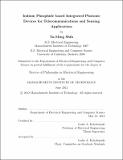Indium phosphide based integrated photonic devices for telecommunications and sensing applications
Author(s)
Shih, Ta-Ming, Ph. D. Massachusetts Institute of Technology
DownloadFull printable version (3.281Mb)
Alternative title
InP based integrated photonic devices for telecommunications and sensing applications
Other Contributors
Massachusetts Institute of Technology. Dept. of Electrical Engineering and Computer Science.
Advisor
Leslie A. Kolodziejski.
Terms of use
Metadata
Show full item recordAbstract
Photonics is an exciting area of study that is situated at the cross-section of physics, material science, and electrical engineering. The integration of photonic devices serves to reduce the size, weight, power consumption, and cost of the photonics- based systems, whose applications can be as disparate in nature as communications and medicine. In particular, an integrated all-optical logic gate and wavelength converter for fiber-optic telecommunications and an integrated tunable laser for trace-gas sensing are investigated in this thesis. These devices are fabricated in the indium phosphide (InP) material system, which includes InP and the ternary/quaternary III-V semiconductors that can be grown closely lattice-matched on the InP substrate. The all-optical logic gate is designed as a Mach-Zehnder interferometer with semi- conductor optical amplifiers as active nonlinear elements that are optically coupled to the passive waveguides using the asymmetric twin waveguide technique. The device is grown and fabricated monolithically and carrier-dependent optical interference is demonstrated at the 1.55 [mu]m wavelength. The tunable diode laser is designed to operate in the wavelength range of 1.55 [mu]m - 2 [mu]m for trace-gas spectroscopic sensing and comprises of strained InGaAs quantum wells. The laser is monolithically fabricated using mask-less lithography techniques and tuning is demonstrated in Fabry-Perot cavity lasers under continuous-wave operation. A ring-coupled 2 [mu]m wavelength laser is designed that will exhibit a tuning range of tens of nanometers.
Description
Thesis (Ph. D.)--Massachusetts Institute of Technology, Dept. of Electrical Engineering and Computer Science, 2012. This electronic version was submitted by the student author. The certified thesis is available in the Institute Archives and Special Collections. Cataloged from student-submitted PDF version of thesis. Includes bibliographical references (p. 193-205).
Date issued
2012Department
Massachusetts Institute of Technology. Department of Electrical Engineering and Computer SciencePublisher
Massachusetts Institute of Technology
Keywords
Electrical Engineering and Computer Science.